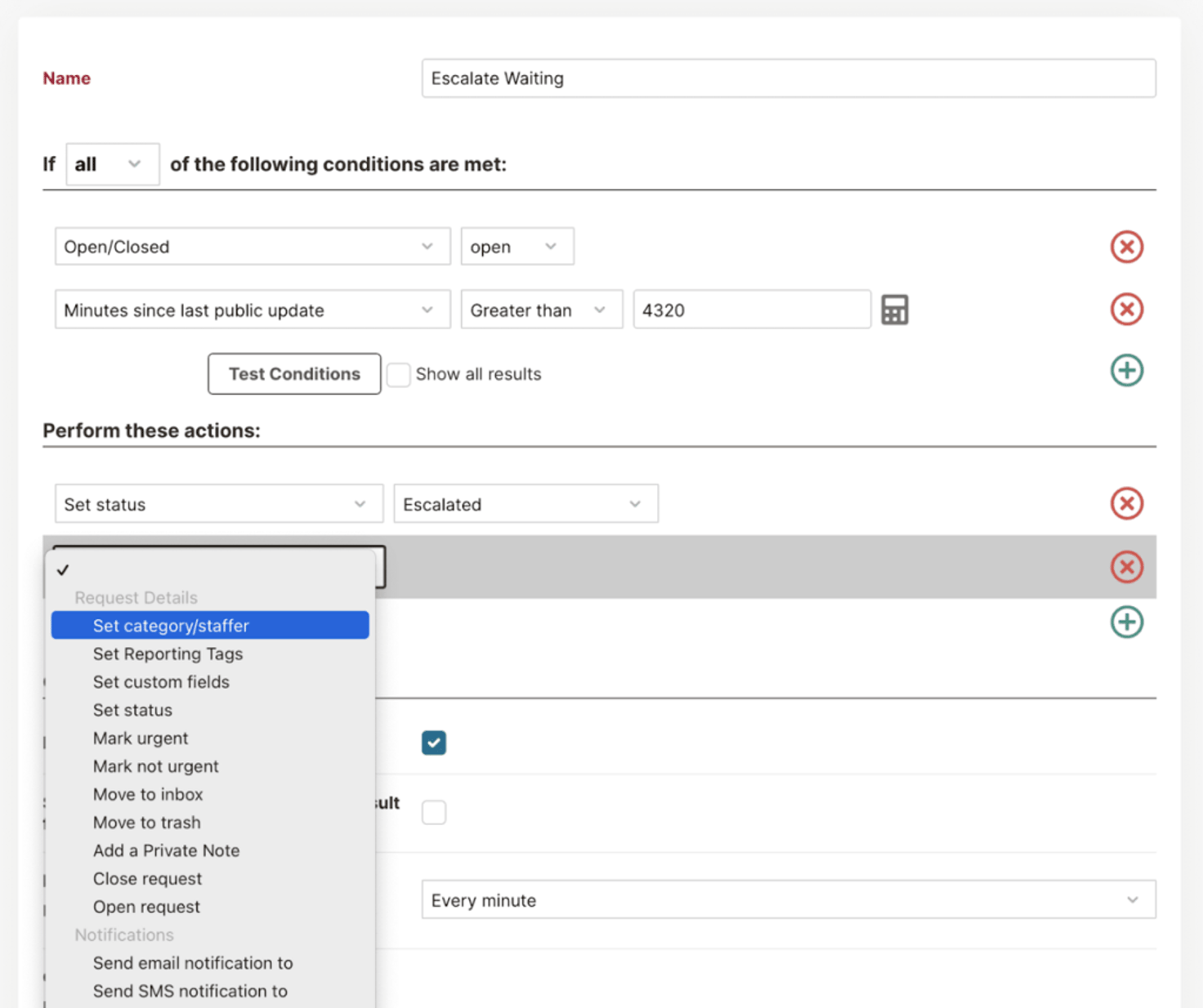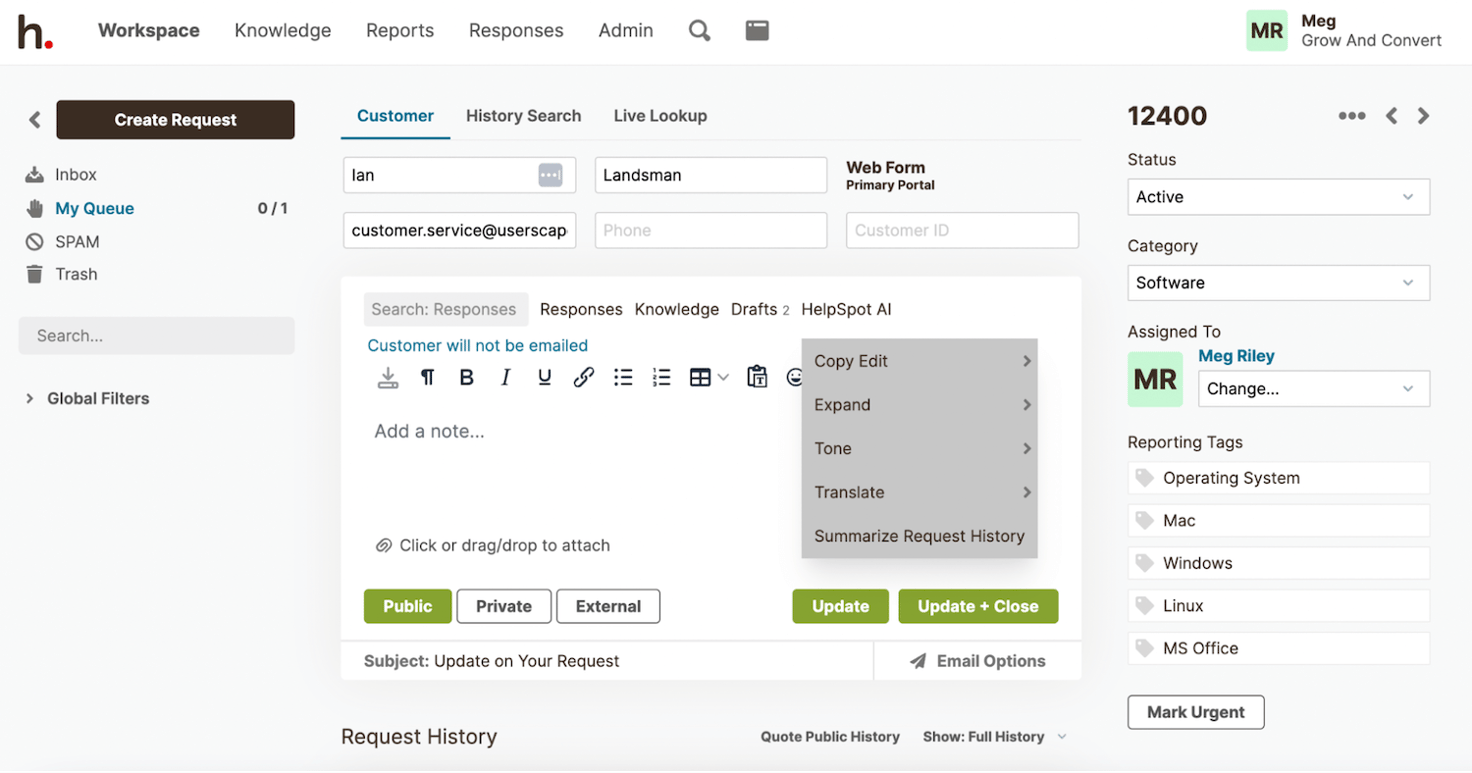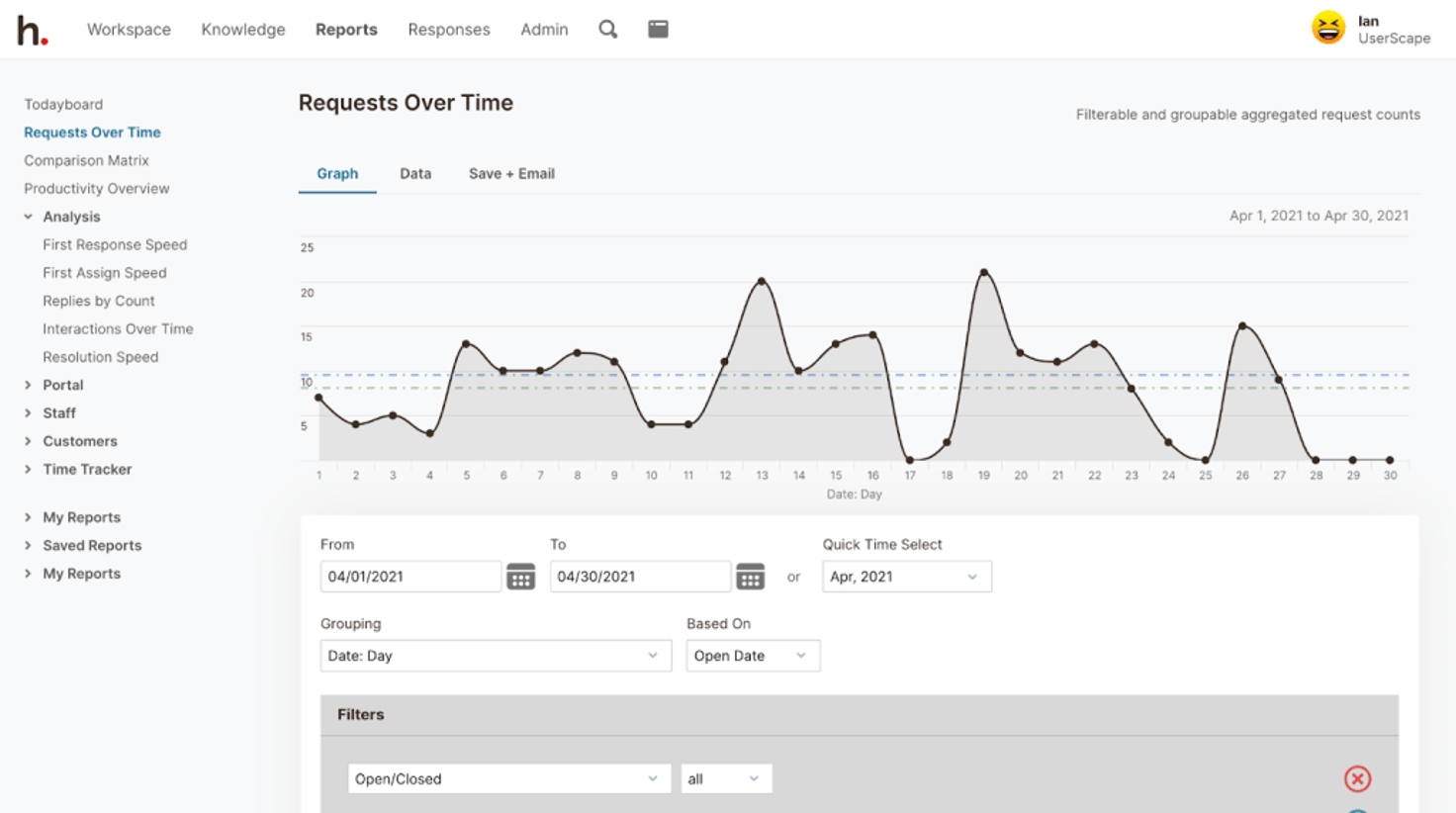How Can AI Help Customer Service Agents Improve Support?

AI tools like ChatGPT are here to stay — businesses far and wide are using AI to promote operational efficiencies, help staff work more productively, and ultimately, save time and money. As more and more businesses adopt these technologies, research finds that AI offers significant benefits for customer service teams, specifically.
For example, it can:
- Improve the customer experience by helping agents provide prompt, helpful support.
- Speed up first response times, reduce handle times, and increase the number of resolved tickets per hour.
- Reduce ticket volume and eliminate low-level tasks.
- Help low-performing agents work more efficiently and provide assistance for new agents.
- Prevent employee burnout.
- Provide more detailed insights on customer issues and overall satisfaction with your brand.
- And more.
Now, we understand the initial hesitations with AI — Will it replace customer service agents? Will customers feel comfortable engaging with it? Is it accurate, reliable, and secure?
But teams are confidently embracing AI because it shows to support workflows. It’s not replacing human agents — now or into the foreseeable future — but can automate and streamline repetitive tasks. And although it’s proven to improve customer satisfaction, high-quality support still requires human-to-human interaction (and there are cases in which customers prefer the help of a real person).
So even though AI is advancing and becoming more popular, it doesn’t have the capability to change the customer service industry completely: adopting AI simply means you can keep up with competitors’ strategies to provide better customer support.
That’s why most help desk software brands (like us!) are starting to integrate AI into their offerings. You can leverage the benefits of these tools in the ticketing system you already use to communicate with customers and provide support. It’s a seamless process as there’s no big learning curve.
In this guide, we discuss the best ways to integrate AI into your support workflows and its benefits for agents and customers.
But first, let’s talk more about AI models like ChatGPT and what they can realistically do to support customer service workflows.
You can also explore our help desk’s AI features by starting a free trial of HelpSpot.
ChatGPT for Customer Service: Overview, Pros & Cons
In basic terms: Artificial intelligence (AI) language models analyze, understand, and generate human language. They are a key component of natural language processing (NLP) tools.
For example, ChatGPT is a generative AI chatbot designed for conversational interaction.
When integrated into your help desk solution, these AI models can support customer service interactions by:
- Understanding customer queries and sending automatic replies to common requests.
- Routing requests to the best agents to answer specific customer questions.
- Helping agents draft replies to customer queries — they can auto-complete replies and be used to “edit” and improve writing.
- Translating support tickets and enabling staff to provide multilingual support.
- Performing sentiment analysis to summarize ticket details and help agents understand the types of issues customers experience.
Overall, AI models prove valuable — they accelerate processes; help agents send faster, more helpful, and polished replies; provide detailed insights to anticipate customers’ needs, address common issues at their root causes, and improve the overall experience with your brand.
Note: We’d be remiss if we didn’t mention customer service chatbots. Many teams use a chatbot solution to provide 24/7 online support, as you can configure these solutions to manage specific customer issues. These are often built on AI language models and offer time-saving benefits for teams that receive many repetitive requests. Plus, you can often integrate these with your broader help desk solution to aggregate request data.
However, the pitfall with AI tools is that the information they deliver is only as good as the information you feed them.
Even ChatGPT warns about their solution: “ChatGPT sometimes writes plausible-sounding but incorrect or nonsensical answers.”
And sure, AI language models are innovative because they’re always “learning” — they can analyze the available data in your help desk and be “trained” to support your specific needs — which allows them to work better for you. But they’re still imperfect and cannot be relied on for consistently accurate answers. And they very rarely can manage complex requests.
Therefore, you can’t blindly trust AI technologies to analyze and handle all of your customer support tickets. They’re simply not that advanced.
AI tools still require human intervention to: 1) feed detailed prompts, and 2) check replies are accurate, make sense, and flow well (and are the best representation of your brand). In reality, replies should be viewed as a “jumping off point” — AI tools can do some heavy lifting for you, but you can’t entirely bank on them.
Now let’s talk about how to strategically use AI technologies in your support flows.
| Pro Tip: You can use ChatGPT to build out customer service templates, support documentation, and other knowledge base resources. (For example, you could tell it to write a canned reply for an order confirmation email or a password reset message.) Of course, these will require some fine-tuning and personalization, but ChatGPT can greatly assist in the writing process. You can then add these resources to your help desk portal or website for easy reference. |
How HelpSpot’s AI-Powered Features Support CS Agents
HelpSpot’s AI help desk features streamline every stage of the support process:
- Automation rules organize and assign new tickets.
- Canned replies, templates, and other AI-enabled tools help agents respond to and resolve tickets more easily.
- Reporting tells you more about customer issues and how they’re solved so you can fine-tune website resources and pinpoint areas to improve processes — this makes everybody happy: customers can find answers to questions without relying on agents, and agents have fewer tickets to manage.
First, you can create automation rules (based on if/then scenarios) to categorize and route tickets to the right support agents.
Our platform can analyze the content of support requests to identify customer issues and determine the next best steps. You can train our platform to auto-send canned replies to specific requests. Or, you can automatically route tickets by category or keyword, divvy tickets by available agent, prioritize and escalate specific types of requests, and more.
You can also create rules based on time from the last response: if a ticket has gone a certain number of hours without being assigned or receiving a reply, HelpSpot can automatically escalate and reassign the ticket.

You can use triggers to route and reassign tickets based on certain actions. So if you have a more complex request that requires multiple agents, you can set triggers that pass the ticket along after specific steps are complete.
These rules are super flexible, and since AI can review all ticket details before taking action, you can get really specific in how you assign requests and keep tickets moving.
Using AI and automation to handle ticket routing saves agents time: they can work down their queue and focus on the requests they’re best suited to handle.
HelpSpot has AI-powered tools within tickets to help agents:
- Send quicker (but still accurate, clear, and helpful) replies.
- Reduce customer wait times.
- Provide smoother customer service experiences.

First, HelpSpot provides suggested actions based on factors like ticket type, past resolution processes, previous customer interactions, and other criteria. We can suggest canned replies, templates, or knowledge base resources to quickly shoot off to customers.
Then, as you draft replies, you can:
- Use the ‘Copy Edit’ feature to improve writing, check spelling and grammar, and make your writing more concise.
- Auto-complete replies with the Expander — just type a few lines to start the reply, and AI will fill in the gaps. It can even turn the information into a tutorial. Of course, as we warned above, you’ll still want to double-check AI answers to make sure all details are accurate and approved by your team.
- Adjust the tone of your reply — our AI tool can make your response sound more casual, formal, apologetic, or positive.
- Translate customer queries and send replies in their preferred language. HelpSpot currently supports Spanish, Dutch, French, German, Hindi, Japanese, Mandarin, and Arabic translations.
- Summarize the request history and quickly get up to speed on the important ticket details.
You can easily put your best foot forward in every customer interaction and find faster resolutions to issues.
These features boost productivity for all agents, but they are even more beneficial for low-performing and new agents because AI tools can fill in knowledge gaps. If agents don’t know exactly how to resolve a request, they can look at suggested templates or drop in knowledge base resources; if they’re slow at replying or prone to grammar mistakes, they can use AI to auto-complete and edit replies. Everybody has the resources to be a top performer.
AI also comes in handy for support managers because it analyzes large amounts of data and provides deeper insights about:
- Customer issues.
- How agents resolve issues.
- How customers feel about the support they received and their experience with your brand.
In turn, these tools can help you:
- Recognize the most common customer requests.
What types of issues do customers experience most frequently, and how can you mitigate those issues to 1) make customers’ lives easier, and 2) reduce the number of tickets your team receives?
For example, if customers frequently email about a problem with a particular product or product feature, you can brainstorm ways to nip the issue in the bud. Alternatively, if you recognize customers have questions about specific product features and functionality, you can publish resources to customer self-service pages on topics they express confusion about.
- Identify top-performing customer service representatives (and which agents need more help).
You can dig into individual agent performance and provide clearer feedback on what they’re doing right and where they can improve. You can also identify reps that need more individualized training and determine ways to troubleshoot. In addition, you can see which types of requests trip agents up and provide training resources on those issues.
- Discover what customers like and don’t like about your brand (specific products, services, support interactions).
Reporting tools make it easy to identify common themes and key pieces of feedback from customer surveys. You can see big-picture details and then review individual surveys or support tickets to learn more about specific customer experiences. This feedback can also help you refine surveys with more pointed questions and receive better customer insights.

All of HelpSpot’s reporting tools are customizable and offer real-time data, so you can report on various metrics and look at data over different periods. Our help desk also integrates with other customer service tools, like CRM systems and AI-powered chatbots, so you can view all reporting data in one place.
Read more: The Complete Guide to Customer Service Reporting
How AI Improves the Support Experience & Customer Satisfaction
As we’ve stressed, AI works hand-in-hand with your CS agents to promote better customer interactions. And, as you might imagine, better support leads to happier customers — and happier customers lead to more loyal customers.
Customers appreciate speedy responses. In fact, as AI technologies are becoming more popular, customers expect faster replies.
A 2020 survey found that 46% of customers (of the 3,200 surveyed) expect replies to support emails in less than 4 hours. And a third of respondents said they expect a reply within the hour. However, the average support team can take between 12 to 36 hours to respond to email — so the quicker you can get back to customers, the better chance you have of winning their business and improving retention.
The expectations are even greater when communicating via live chat or social media, as customers expect replies within minutes.
Even better than speedy replies? Self-service resources. Most customers prefer to find answers to questions without contacting your team. (Even if you do provide the most delightful support.) It’s just easier to search your website for resources and find answers to FAQs in the moment. Plus, customers are more likely to trust and engage with your brand when they can easily learn about what you offer and see proof that your brand provides helpful support.
As mentioned above, HelpSpot reporting lets you dig into customer issues to see where your support resources are lacking. Our reporting tool can even show you what customers search for in self-service portals so you can identify queries that generate no results and bridge the gaps. Then, customers can browse your site when they have questions instead of submitting tickets and waiting (any amount of time) for your team to reply.
AI-powered help desk tools enable consistent support and reduce human error, improving quality at scale. Support staff can work off of the right templates and knowledge base documents, responses to customers are accurate and edited, and agents have resources to fully resolve queries without a lot of back and forth.
When you have the tools to consistently provide good support and deliver on expectations, you keep existing customers happy, improve your brand reputation, and continue building upon your customer base.
And although traditional customer service and help desk software can support workflows and promote more efficient support processes, AI takes those capabilities to a higher level and empowers support agents to be productive and successful in their roles.
To learn more about HelpSpot’s AI help desk, contact our team for a walkthrough or demo our platform for free.
You can also read more about HelpSpot’s benefits for customer service teams in our guides:
- The Best Team Inbox Management Solution (Hint: It’s Not Using Folders)
- 7 Shared Mailbox Management Best Practices Guide
- Best Customer Service Email Management Software: Compare Your Top Options
FAQs About AI in Customer Service
What are the best ways to use ChatGPT for customer support?
Customer service teams can use ChatGPT to:
- Draft replies to customer inquiries (remember, the better the prompt, the better the reply).
- Create templates and canned responses to save and use in the help desk.
- Draft knowledge base resources and self-service documentation to publish on their website for customer access.
- Write email newsletters.
- Build website and social media content — you can use AI to write product descriptions, brochures, blog posts, white papers, case studies, video scripts, and more.
- Reply to customer reviews online.
- Answer FAQs or questions customers submit on your Google Business Listing.
You can also use ChatGPT to brainstorm solutions to problems — you can ask it for advice, and it’ll provide insights. For example, you could ask it for brand awareness strategies or tips on engaging with customers, and it’ll produce a list of ideas.
But of course, you should double-check everything ChatGPT generates to ensure it’s clear, accurate, and logical.
What are the other popular AI language models?
Some of the most popular large language models (in 2023) include:
- OpenAI’s GPT-3 — and the more advanced GPT-3.5 and GPT-4 versions
- Google’s BERT, LaMDA, and PaLM
- MetaAI’s LLaMA
- Microsoft’s MT-NLG
- BigScience’s BLOOM
What are the different AI technologies customer service teams use?
Chatbots are among the most popular AI-powered customer service tools because they can handle simple customer requests and send immediate replies. Bots use machine learning and NLP to perform sentiment analysis and either send a reply or route customers to an agent for help. Then agents can pick up where bots leave off and provide quick resolutions.
In addition to chatbots, VoiceAI is a go-to technology for teams that manage customer requests via phone. Voice AI can automate call center interactions and direct callers to the correct departments/agents.
AI can also be used in support workflows to power data management, provide predictive analytics, and handle omnichannel routing (amongst other things).

